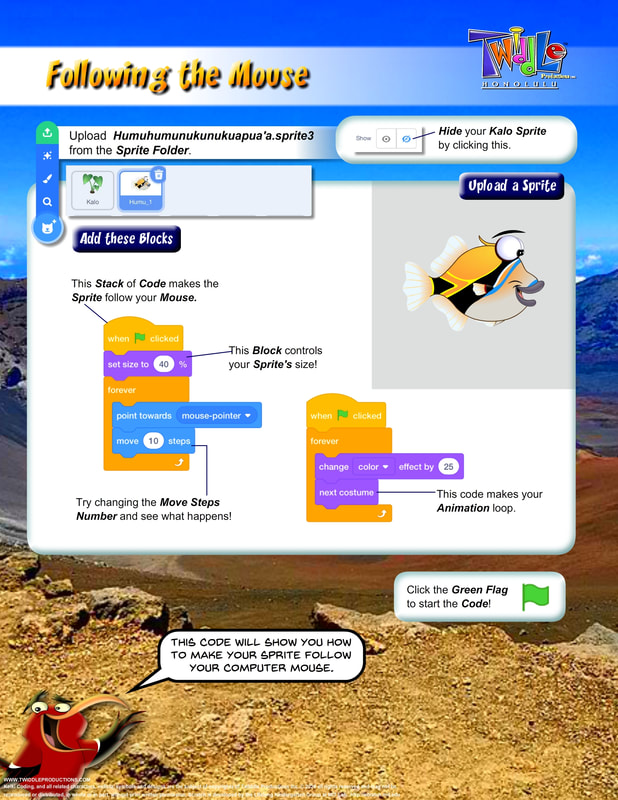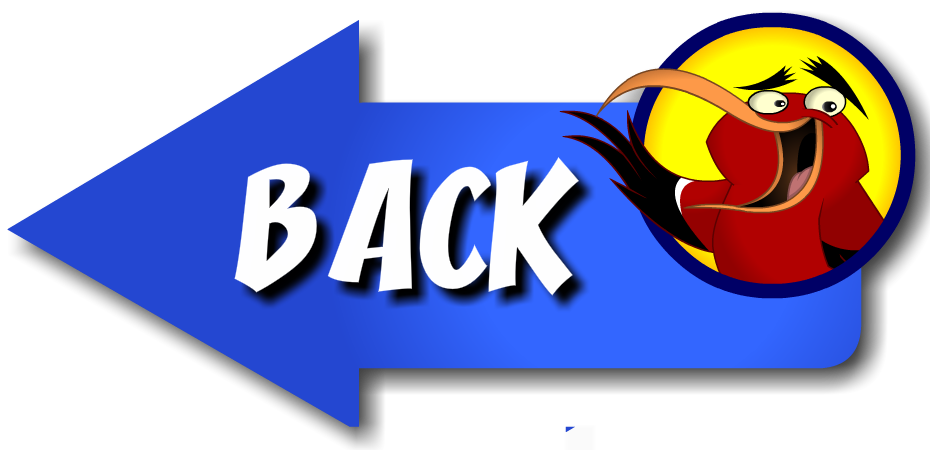
Time For The Basics
Now that you have an account, taken the Scratch tour and have downloaded all the assets, you're ready to start coding! These 10 basic exercises are very important and will help you to learn how coding works. I know, I know, everyone's super excited to make their first game, but by starting with the basics first, you will make your coding brain even stronger, which in turn will help make coding easier for you.
What do you say? Shall we get started?
Now that you have an account, taken the Scratch tour and have downloaded all the assets, you're ready to start coding! These 10 basic exercises are very important and will help you to learn how coding works. I know, I know, everyone's super excited to make their first game, but by starting with the basics first, you will make your coding brain even stronger, which in turn will help make coding easier for you.
What do you say? Shall we get started?

Kalo
▶ Tropical plant grown primarily for its edible corms, a root vegetable most commonly known as taro, or kalo in Hawaiian. Kalo is a staple food in Hawaii and is known as the plant that gives us poi, kulolo, and laulau.
The Kalo is also considered a sacred plant in Hawai‘i and is directly tied to the story of how the very first man named Hāloa was born and became the first Hawaiian person.
▶ Tropical plant grown primarily for its edible corms, a root vegetable most commonly known as taro, or kalo in Hawaiian. Kalo is a staple food in Hawaii and is known as the plant that gives us poi, kulolo, and laulau.
The Kalo is also considered a sacred plant in Hawai‘i and is directly tied to the story of how the very first man named Hāloa was born and became the first Hawaiian person.

Humuhumunukunukuapua'a
▶ The reef triggerfish, also known as the rectangular triggerfish or by its Hawaiian name humuhumunukunukuāpuaʻa, also spelled humuhumunukunukuapua'a or just humuhumu for short, is one of several species of triggerfish. It is found at reefs in the Indo-Pacific and is the state fish of Hawaii.
▶ The reef triggerfish, also known as the rectangular triggerfish or by its Hawaiian name humuhumunukunukuāpuaʻa, also spelled humuhumunukunukuapua'a or just humuhumu for short, is one of several species of triggerfish. It is found at reefs in the Indo-Pacific and is the state fish of Hawaii.

The Happy Face Spider
▶ Theridion grallator, also known as the Hawaiian happy-face spider, is a spider in the family Theridiidae. Its Hawaiian name is nananana makakiʻi. This spider is normally shy and is hard to find. It lives on the undersides of leaves in rainforests, mainly on the Big Island. It hunts primarily at night and feeds on small insects that it encounters. The “happy face” pattern is variable and has dozens of different patterns. It is thought by some that the patterns may keep them from being eaten by birds.
▶ Theridion grallator, also known as the Hawaiian happy-face spider, is a spider in the family Theridiidae. Its Hawaiian name is nananana makakiʻi. This spider is normally shy and is hard to find. It lives on the undersides of leaves in rainforests, mainly on the Big Island. It hunts primarily at night and feeds on small insects that it encounters. The “happy face” pattern is variable and has dozens of different patterns. It is thought by some that the patterns may keep them from being eaten by birds.

Feral Chickens
▶ In Hawai'i, wild chickens and roosters are a commen site. The chicken or "moa" as it is called in Hawaiian was originally introduced to the islands by early Polynesians as a source of food. On the island of Kauai, feral chickens are descendants of birds that escaped and bred with wild roosters when Hurricane Iwa hit in 1982 and then Hurricane Iniki in 1992 blew open farmers chicken coops.
▶ In Hawai'i, wild chickens and roosters are a commen site. The chicken or "moa" as it is called in Hawaiian was originally introduced to the islands by early Polynesians as a source of food. On the island of Kauai, feral chickens are descendants of birds that escaped and bred with wild roosters when Hurricane Iwa hit in 1982 and then Hurricane Iniki in 1992 blew open farmers chicken coops.

Nene Geese
▶ The nene, also known as the Hawaiian goose, is a species of bird endemic to the Hawaiian Islands. It is the official bird of the state of Hawaiʻi, and is exclusively found in the wild on the islands of Oahu, Maui, Kauaʻi, Molokai, and Hawaiʻi. The Hawaiian name nēnē comes from its soft call.
▶ The nene, also known as the Hawaiian goose, is a species of bird endemic to the Hawaiian Islands. It is the official bird of the state of Hawaiʻi, and is exclusively found in the wild on the islands of Oahu, Maui, Kauaʻi, Molokai, and Hawaiʻi. The Hawaiian name nēnē comes from its soft call.

Hawaiian Monk Seal
▶ The Hawaiian monk seal, is an endangered species of earless seal that is endemic to the Hawaiian Islands. The Hawaiian monk seal is one of two remaining monk seal species; the other is the Mediterranean monk seal. A third species, the Caribbean monk seal, is extinct.
▶ The Hawaiian monk seal, is an endangered species of earless seal that is endemic to the Hawaiian Islands. The Hawaiian monk seal is one of two remaining monk seal species; the other is the Mediterranean monk seal. A third species, the Caribbean monk seal, is extinct.

Hawaiian Hoary Bat
▶ The Hawaiian hoary bat or ʻōpeʻapeʻa is an endangered species related to the mainland American hoary bat. The Hawaiian hoary bat is one of two species of mammal that are endemic to the islands, the other being the Hawaiian monk seal.
▶ The Hawaiian hoary bat or ʻōpeʻapeʻa is an endangered species related to the mainland American hoary bat. The Hawaiian hoary bat is one of two species of mammal that are endemic to the islands, the other being the Hawaiian monk seal.
|
X and Y Coordinates
An X and Y coordinate? What the heck is that all about! Never fear i'll explain.
Stand up! Yup, that's right, stop what your doing and stand up right now. Ready? Now criss cross your arms like a big X that's pointing left to right. Thats your X coordinate! Now stretch your hands straight up and keep your legs together like a big Y that goes up and down! That's your Y coordinate! See, not so scary. Pretty easy right! |

KaLā
▶ KaLā literally means "The Sun". KaLā is very important in the stories of Māui. It is because of KaLā and his selfish ways of flying through the sky so fast that Māui's mother Hina couldn't dry her Kapa (Kapa is fabric made from the bark of trees).
Māui, in order to make Hina happy climbed the summit of Haleakalā “house of the sun” on the island of Maui and fought him. During this great battle Māui broke KaLā's light rays and forced him to fly slower across the skies, thus giving the people of the world seasons.
This made Hina very happy because she could now dry her Kapa properly. In time Māui and KaLā became great friends and KaLā learned the meaning of Aloha.
Now, there is another version of this story that takes place on the island of Oahu at Pu'u Heleakalā in Nanakuli. Heleakalā means "where the sun is snared."
▶ KaLā literally means "The Sun". KaLā is very important in the stories of Māui. It is because of KaLā and his selfish ways of flying through the sky so fast that Māui's mother Hina couldn't dry her Kapa (Kapa is fabric made from the bark of trees).
Māui, in order to make Hina happy climbed the summit of Haleakalā “house of the sun” on the island of Maui and fought him. During this great battle Māui broke KaLā's light rays and forced him to fly slower across the skies, thus giving the people of the world seasons.
This made Hina very happy because she could now dry her Kapa properly. In time Māui and KaLā became great friends and KaLā learned the meaning of Aloha.
Now, there is another version of this story that takes place on the island of Oahu at Pu'u Heleakalā in Nanakuli. Heleakalā means "where the sun is snared."

Box Jellyfish
▶ The box jellyfish visits the warm waters of Hawai'i monthly and is most commonly found on Hawaii's leeward (west) and south shores. Their arrival on Hawai'i ’s beaches is quite predictable and they usually arrive around 9-12 days after a full moon (but occasionally they have been observed on off-cycle days as well). This is when warning signs are usually posted on many beaches.
▶ The box jellyfish visits the warm waters of Hawai'i monthly and is most commonly found on Hawaii's leeward (west) and south shores. Their arrival on Hawai'i ’s beaches is quite predictable and they usually arrive around 9-12 days after a full moon (but occasionally they have been observed on off-cycle days as well). This is when warning signs are usually posted on many beaches.





































